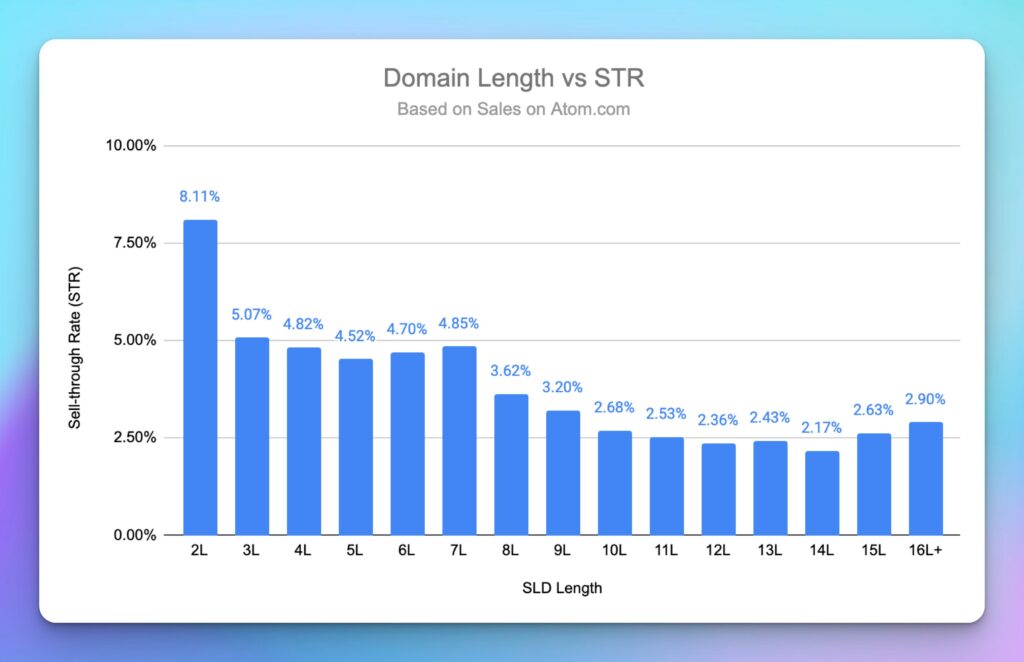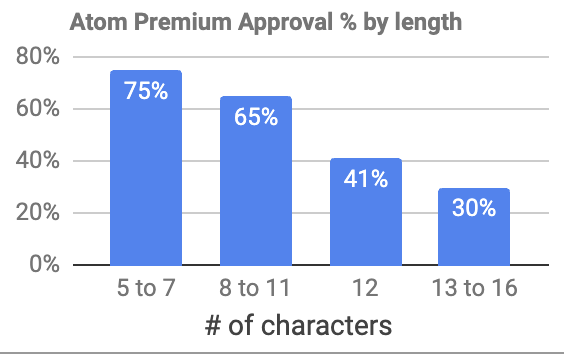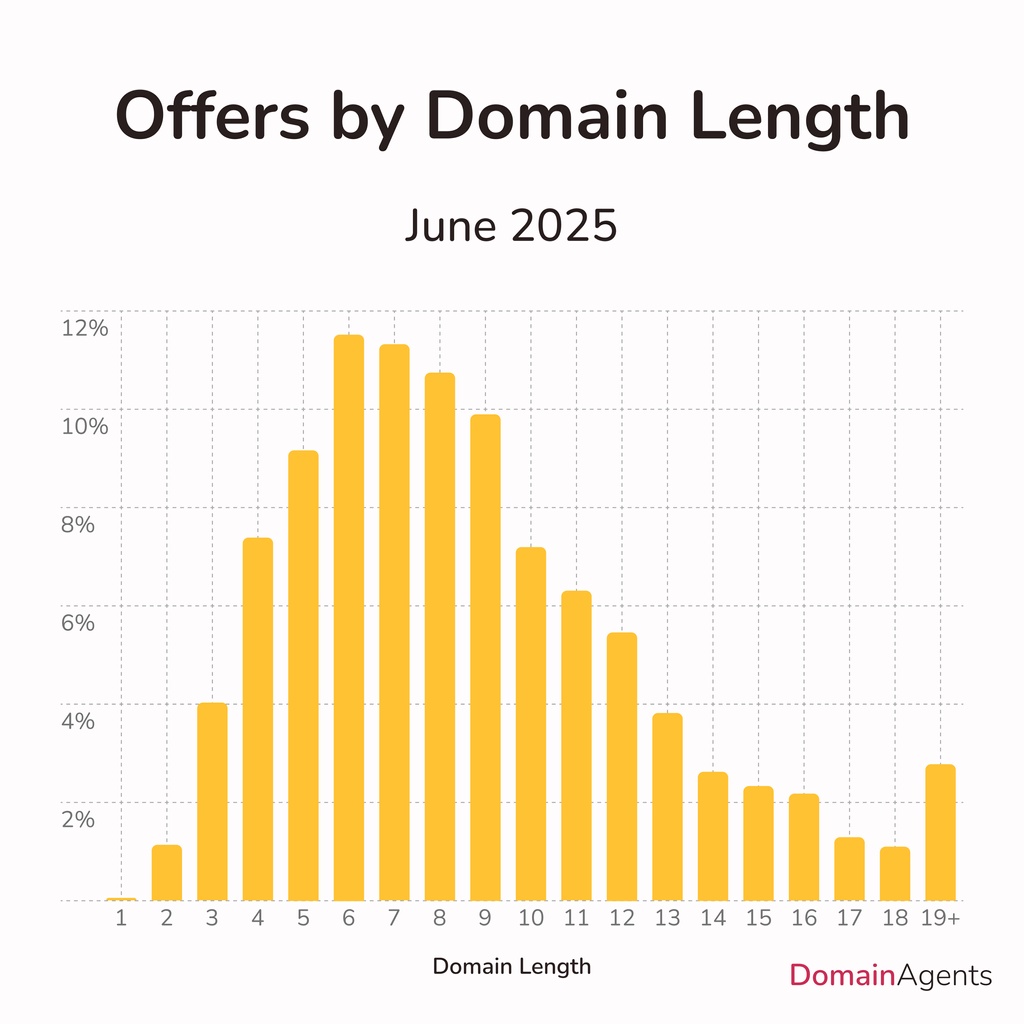The length of a domain name plays a pivotal role in determining its marketability and value. Shorter domain names are often prized for their memorability, ease of use, and branding potential, but is there an ideal length that maximizes success?
Recent data from three prominent sources—Atom.com, NameGroove, and Domain Agents—shed light on this question, offering valuable insights for domain investors looking to optimize their portfolios.
1. Sell-Through Rate (STR)
Atom.com, a leading domain marketplace, released sell-through rate (STR) data in June 2025, which measures the percentage of listed domains that successfully sell. The data highlights a clear correlation between domain length and sales success:

| Domain Length | Sell-Through Rate (STR) |
|---|---|
| 3 letters | 5.1% |
| 7 letters | 4.8% |
| 12 letters | 2.3% |
The trend is evident: shorter domains have higher STRs, with a gradual decline as length increases. The drop becomes particularly sharp after 7 letters, with 12-letter domains selling at less than half the rate of 3-letter domains.
This suggests that buyers strongly favor concise domains, likely due to their ease of recall and typing. The data, shared by Atom’s CEO Darpan Munjal, emphasizes that “every extra letter makes a difference” in the competitive domain market.
2. Premium Approval Rates
NameGroove, a respected name in the domain industry, conducted an internal portfolio analysis to examine premium approval rates by domain length. Premium listings on platforms like Atom.com are often reserved for high-value domains, making approval rates a key indicator of perceived quality. NameGroove’s findings align closely with Atom’s STR data:

| Domain Length | Premium Approval Rate |
|---|---|
| 5-7 characters | 75% |
| 8-11 characters | 65% |
| 12 characters | 41% |
| 13-16 characters | 30% |
According to NameGroove, 75% of premium approvals occur for domains with 5-7 characters, with a significant drop at 12 characters and an even steeper decline for domains with 13 or more characters. This reinforces the preference for shorter domains, as they are more likely to be recognized as premium assets, increasing their marketability and potential value.
3. Offers by Domain Length
Domain Agents, a domain brokerage firm, provided additional insights in July 2025 by analyzing the percentage of offers received based on domain length for June 2025. Their data further supports the trend toward shorter domains:

| Domain Length | Percentage of Offers |
|---|---|
| 5-9 characters | ~11-12% (peak at 6) |
| <5 or >9 characters | Decreases |
The analysis shows that domains with 5-9 characters, particularly those around 6 characters, received the highest percentage of offers, forming a bell-shaped distribution with a clear peak. Offers drop sharply for domains longer than 9 characters, indicating that investors and buyers prioritize concise, brandable names.
Domain Agents noted that “short brandable names with 5–9 characters stayed on top among investors,” highlighting their appeal in the marketplace.
Why Shorter Domains Are Preferred
The consistent preference for shorter domains across these datasets can be attributed to several key factors:
- Memorability: Shorter domains are easier for users to remember, making them ideal for branding and marketing purposes. A concise name like “Zoom.com” is more likely to stick in a user’s mind than a longer alternative.
- Ease of Use: Domains with fewer characters are simpler to type, reducing the risk of errors that could lead users to the wrong website. This is particularly important for mobile users.
- Brandability: Shorter domains often allow for creative, catchy names that resonate with audiences and align with modern branding trends.
- Perceived Value: In the domain market, shorter domains are often seen as premium assets, commanding higher prices due to their scarcity and versatility.
These advantages make domains with 5-9 characters, especially 6-8 characters, highly sought after by businesses and investors alike.

Implications for Domain Investors
For domain investors, these findings offer actionable insights to optimize portfolio strategies:
- Prioritize 5-9 Character Domains: Focus on acquiring and listing domains within this length range, particularly those with 6-8 characters, to maximize sell-through rates and premium approval chances.
- Consider Keyword Relevance: While brevity is critical, longer domains can still perform well if they include highly relevant or targeted keywords. For example, a 12-letter domain like “MyNewTechBit.com” may appeal to specific industries despite its length.
- Balance Pricing and Quality: Shorter domains may command higher prices, but investors should ensure pricing aligns with market trends and domain quality to avoid deterring buyers.
- Monitor Market Trends: Stay informed about evolving preferences, such as the growing popularity of certain top-level domains (e.g., .ai), which may influence demand for specific domain lengths.
Investors can increase their chances of successful sales and higher returns by aligning their strategies with these data-driven insights.
Addressing Potential Complexities
While the data strongly favors shorter domains, some industry experts suggest that other factors can influence sales success. For instance, pricing plays a role—shorter domains may have higher STRs partly because they are priced more competitively.
Additionally, the relevance of a domain’s keywords or its alignment with a specific brand can make longer domains viable in certain cases. Investors should weigh these factors alongside length when building their portfolios.
Conclusion
The data from Atom.com, NameGroove, and Domain Agents paints a clear picture: domain names with 5-9 characters, particularly 6-8 characters, are the most desirable in today’s market. Their high sell-through rates, premium approval rates, and offer percentages reflect their appeal to buyers seeking memorable, user-friendly, and brandable domains. For domain investors, prioritizing these lengths while considering other factors like keyword relevance and pricing can lead to more sales.
You May Also Like
- SNS Essentials: How to Setup a Domain and Resolve Your Website
- How Domain Names Are Making Online Identity Verification Easier and Safer
- 13 Mind Hacks to Drive Website Engagement
- Domain Name Appraisal: A Beginner’s Guide to Uncovering Value
- How to Optimize Apache, PHP, and MySQL Performance for a 1GB RAM VPS
